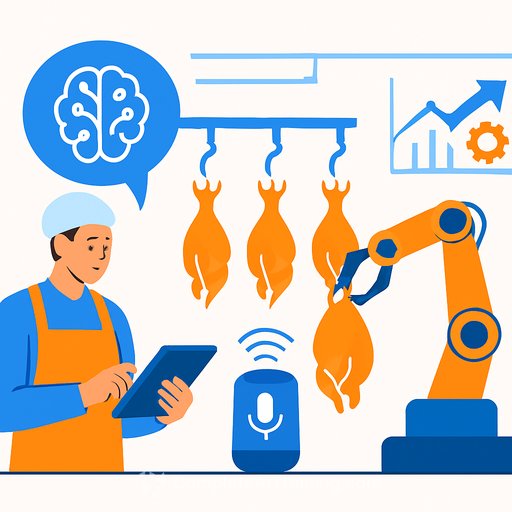AI Takes Flight: Predictive Scheduling and Voice Assistants Reshape Poultry Processing
Product teams are moving from static plans to adaptive systems. Predictive scheduling and voice assistants now coordinate labor, equipment, and inventory in real time. The result: higher yield, less waste, and tighter food safety without slowing the line.
As of October 17, 2025, adoption is accelerating. The playbook is clear: instrument the line, centralize data, automate decisions, and keep humans in the loop with voice-first guidance.
Why this matters for product development
- Shift from reactive firefighting to proactive planning with 14-day self-correcting forecasts.
- Hands-busy environments need hands-free interfaces. Voice cuts context switching and errors.
- Quality and safety move from spot checks to continuous, AI-assisted monitoring.
- Data network effects become a moat: more plants, more birds, better models.
Core use cases to ship first
- Predictive scheduling: match harvest, staffing, and downstream processing to demand.
- Computer vision QC: detect myopathies on raw breast meat; count birds; flag anomalies on belts.
- Voice-guided SOPs: on-the-line checklists, yield troubleshooting, sanitation steps, downtime triage.
- Condition-based maintenance: schedule blade swaps and calibrations before yield drops.
Technical foundations (practical stack)
- Forecasting: regression (linear, SVR) on historicals, environmental data, feed intake, and market signals.
- Vision: YOLOv8 for real-time detection and counting; EfficientNetB7 for fecal image analysis and health flags; BPNNs and SVMs for myopathy classification.
- Voice pipeline: ASR for noisy floors, NLU to parse intent, LLM-backed NLG for responses. Latency < 500 ms at the edge is the bar.
- Feedback loops: online learning to adjust cut plans and staffing by shift based on live yields.
Reference architecture
- Edge: cameras, mics, PLC taps; on-device inference for low-latency safety and counting.
- Stream layer: message bus for telemetry, events, and ASR text.
- Data backbone: feature store, time-series store, and a lake for training data and audit.
- Model ops: CI/CD for models, A/B routing, drift detection, and human-in-the-loop review.
- Control layer: scheduling engine writes back to MES/ERP; voice assistant ties into SOPs and CMMS.
90-day pilot plan
- Weeks 1-2: Scope one line and one flock cohort. Define KPIs and guardrails. Instrument 2-3 cameras and one voice station.
- Weeks 3-4: Ship baseline forecast v1; deploy YOLOv8 for counting; integrate ASR; mock NLU intents for top 10 SOPs.
- Weeks 5-6: Close loop into scheduling sandbox; compare schedule adherence vs control line.
- Weeks 7-8: Add myopathy classifier; start yield-optimized cut plans by SKU mix.
- Weeks 9-10: Introduce maintenance triggers; push voice escalation for downtime events.
- Weeks 11-12: Evaluate KPIs, cost, and operator feedback. Go/no-go criteria for scale-out.
KPIs that matter
- Yield: +1-3% from cut accuracy and reduced trim loss.
- Schedule adherence: +10-20% improvement versus baseline.
- Waste: -15-30% overproduction and inventory write-offs.
- Throughput: +3-7% without extra headcount.
- Quality: false negative rate for myopathies; pathogen detection time to alert.
- Safety/compliance: SOP adherence via voice logs; audit trail completeness.
Voice on the floor: what "good" looks like
- Wake word with noise-resilient ASR; supports accents and code-switching.
- Intent coverage for top 50 SOPs; offline fallback when connectivity drops.
- Short, stepwise prompts; visual QR links near stations for quick escalation.
- Glove-friendly, cold-room-ready devices; < 2 taps to complete a check.
Data and model strategy
- Data quality: automated labeling from PLC events; human review on edge cases.
- Bias checks: compare performance by facility, bird size, lighting, and shift.
- Explainability: highlight features driving schedule changes; show per-frame vision saliency on QC rejects.
- Governance: model cards, versioned datasets, rollback paths, and signed release notes.
Compliance and trust
- Adopt a risk framework such as the NIST AI RMF for model lifecycle controls.
- Align data collection and retention with GDPR and internal policies; clear signage and consent where required.
- Security: zero-trust network segments; encrypted streams; least-privilege access to logs and audio.
Build vs. buy: decision guide
- Platforms: Google and Microsoft cloud AI stacks supply scalable training, vector stores, and MLOps.
- Specialists: BAADER's ClassifEYE for vision QC; Cargill's Birdoo for flock insights; AZLOGICA for IoT and AI telemetry.
- Operators: Tyson Ventures-backed startups bring focused solutions for waste, welfare, and logistics.
- Criteria: edge latency, model retrain cadence, vision accuracy in variable lighting, ASR accuracy at 85-95 dBA, MES/ERP integration, TCO over 36 months.
Roadmap: next 12 months
- Forecasts: continuous, self-correcting 14-day horizons per flock with SKU mix optimization.
- AR + voice: visual overlays for cut lines, sanitation steps, and real-time defect callouts.
- Robotics: advanced deboning and intelligent cutting with millimeter precision.
- QC upgrades: hyperspectral imaging for defect detection and quantum sensors for contamination screening.
- Generative AI: concept-to-product loops that fuse market signals, nutrition goals, and line constraints.
- Traceability: IoT telemetry written to blockchain for end-to-end visibility.
- Hatchery gains: automated chick sexing and ocular vaccination for welfare and throughput.
Change management and upskilling
- Define new roles: line technologist, data steward, and AI ops lead per plant.
- Train supervisors on voice-first SOPs and exception handling; certify operators on basic AI troubleshooting.
- Create a skills ladder with micro-credentials and cross-plant knowledge sharing. For structured paths, see AI courses by job.
Risks to watch and how to hedge
- Overfitting to one plant: maintain multi-site validation and light calibration workflows.
- Model drift: monitor precision/recall weekly; trigger retrains on threshold breaches.
- Over-reliance on forecasts: keep manual overrides with audit and rollback.
- Integration debt: abstract MES/ERP with a stable domain API to avoid brittle point-to-point links.
Final take
The combination of predictive scheduling and voice assistants is a practical upgrade path for poultry plants. Start with one line, prove yield and waste wins, and scale with disciplined MLOps and operator-centric design.
Do this right and you'll ship better products, protect margins, and raise safety standards-while building a defensible data advantage across your network.
Your membership also unlocks:






